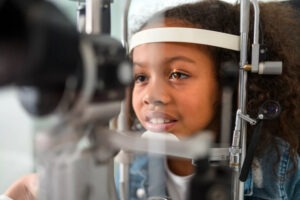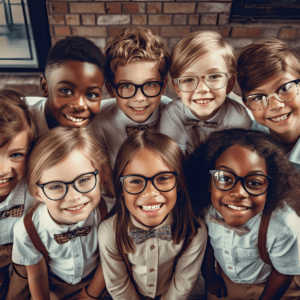The Importance of Pediatric Eye Exams
What Are Pediatric Eye Exams?
Pediatric eye exams are special check-ups to examine your child’s eyes and vision. The eye experts at Levin Eye Care Center are an award-winning team specializing in pediatric care and are qualified to care for your child’s eyes.
Why Are These Eye Exams So Important For Children?
While you might be on top of your game when it comes to regular check-ups, there’s one crucial aspect of your child’s health that sometimes gets overlooked – their eyes. We will explain why Pediatric Eye Exams are super important for your kiddos.
Early Detection of Vision Problems
Imagine your child is struggling to see the chalkboard at school, but they never tell you. That could make it challenging for them to learn. Pediatric Eye Exams can spot common vision issues like nearsightedness (can’t see far), farsightedness (can’t see close), or astigmatism (blurry vision). By catching these problems early, you can help your child see clearly and succeed in school.
Beating Amblyopia (Lazy Eye) with Pediatric Eye Exams
Ever heard of a “lazy eye“? It’s a condition known as Amblyopia, when one eye doesn’t develop correctly because it’s not being used enough. However, Pediatric Eye Exams can spot this too! And when it’s caught early, treatments like our Vision Therapy Program can help the weak eye get stronger. Without treatment, it could cause permanent vision problems.
Detecting Sneaky Eye Diseases
Eye diseases aren’t just for grown-ups. They can affect kids, too! Conditions like glaucoma or cataracts can be found during these eye exams. If they’re detected early, doctors can treat them better and reduce the risk of vision loss. That’s a big win!
Keeping Eyes Healthy
Pediatric Eye Exams don’t just check vision. They look at the eyes’ overall health, and eye infections or allergies can be found and treated. That means less discomfort and fewer eye-related problems for your child.
A Brighter Learning Experience
Good vision is super important for learning! Imagine your child can’t see the words in their books or the teacher’s writing on the board. That can be frustrating and hold them back in school. With regular eye exams, you can make sure your child has the best shot at doing well in school.
No More Headaches and Fatigue
Kids with hidden vision problems might get headaches, feel tired, or have trouble focusing. These can make it harder for them to enjoy school and activities. Pediatric Eye Exams can identify these issues early and offer solutions like glasses or eye exercises to make those problems disappear.
Learning Good Eye Habits
Another cool thing about these exams is that they teach kids about taking care of their eyes. They can learn to manage screen time, use proper lighting, and practice good eye hygiene. It’s all about helping them develop healthy eye habits for life.
Pediatric Eye Exams are vital for your child’s health and well-being. By catching vision problems early, you’re setting your child up for success in school and beyond. Plus, you’re ensuring they have a lifetime of healthy eyes.
Remember, your child’s vision matters, so schedule that eye exam today! Call or Text 219-659-3050 to schedule your appointment.








